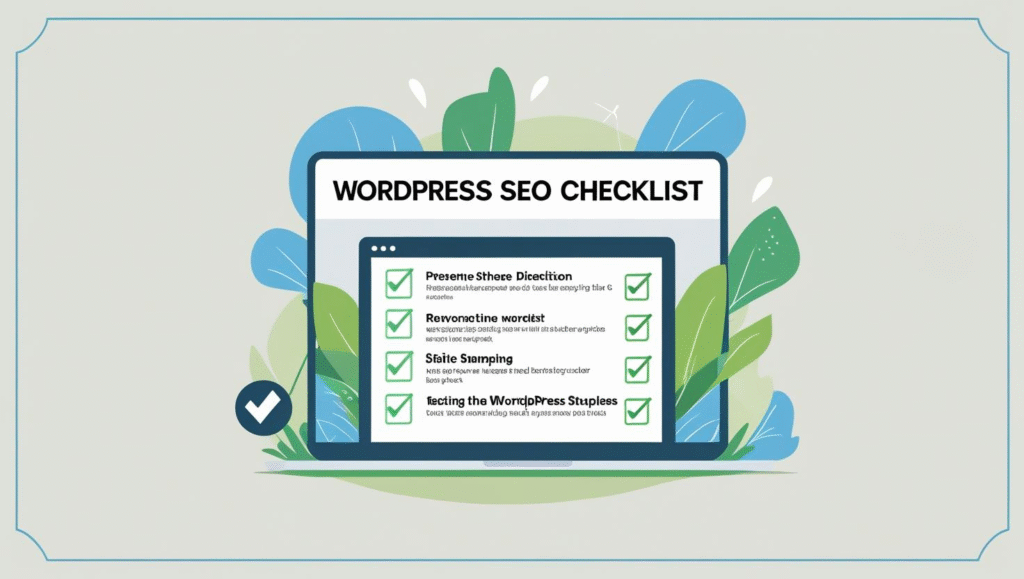WordPress SEO Checklist Search Engine Optimization (SEO) is the key to unlocking consistent, organic traffic for your WordPress website. But with ever-evolving algorithms, plugins, and ranking factors — what actually works in 2025?
In this ultimate WordPress SEO Checklist, you’ll learn simple but powerful optimizations you can apply today to improve your rankings and drive more traffic WordPress SEO Checklist.
Table of Contents
1. Why SEO Still Matters in 2025 WordPress SEO Checklist
Even with social media and paid ads, Google Search remains the #1 source of traffic for most websites. SEO:
- Increases visibility
- Builds trust and authority
- Drives consistent, high-intent traffic
- Saves money on advertising
If you want long-term success, a solid SEO strategy is essential.
2. Use an SEO Plugin (Rank Math or Yoast)
Install a dedicated SEO plugin to control metadata, XML sitemaps, schema, and more WordPress SEO Checklist.
Top SEO Plugins:
- Rank Math SEO (recommended in 2025)
- Yoast SEO
- SEOPress
These tools simplify technical SEO tasks and help you focus on content and structure.

3. Optimize Your Permalink Structure WordPress SEO Checklist
Use clean, readable URLs that include your target keyword.
Best Practice:
/blog-post-title/ instead of /index.php?p=123
Go to Settings → Permalinks and choose Post Name.
Avoid stop words like “and,” “with,” “the,” etc.
4. Conduct Keyword Research the Smart Way
Find what your audience is searching for using:
- Google Keyword Planner
- Ubersuggest
- Ahrefs / SEMrush
- Answer the Public
- Google Search Console
Target:
- High-volume, low-competition keywords
- Long-tail keywords for new content
- Related questions and PAA (People Also Ask)
5. Optimize Title Tags and Meta Descriptions
WordPress SEO Checklist Your title tag is the first impression in search results. Keep it:
- Under 60 characters
- Includes focus keyword
- Written to entice clicks
Meta description:
- 150–160 characters
- Summarizes the post with a CTA
- Includes secondary keywords naturally
Use your SEO plugin to edit these easily.
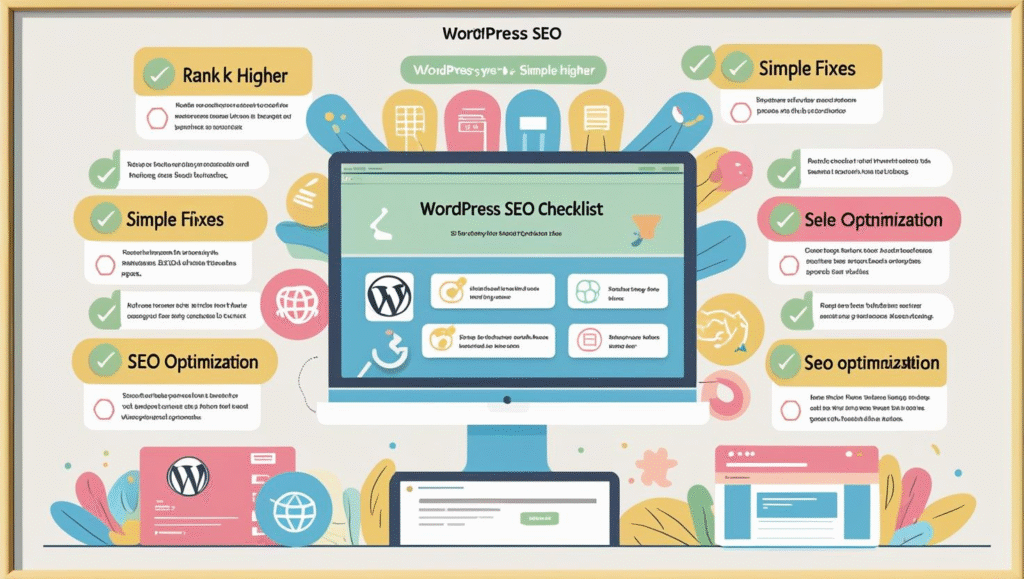
6. Use Header Tags Properly (H1 to H6)
Structure matters — both for SEO and readability.
- H1: Only one per page (the post title)
- H2–H4: Subheadings that break content into sections
- Helps with Google understanding and featured snippets
7. Create High-Quality, Keyword-Rich Content
Google values helpful, relevant content. In 2025, quality > quantity.
- Write for humans, not just search engines
- Include your keyword in the first 100 words
- Use variations (LSI keywords)
- Use bullet points, short paragraphs, and bolding
- Keep content up to date
8. Optimize Images with Alt Text and Compression
Images improve UX, but can hurt performance if not optimized.
Tips:
- Use WebP or AVIF formats
- Add descriptive alt text (including keywords)
- Use tools like ShortPixel, Smush, or Imagify
- Resize before uploading (avoid 5MB+ images)
9. Internal Linking Strategy
Help users and search engines navigate your site.
- Link to related posts/pages using descriptive anchor text
- Use at least 3–5 internal links per blog post
- Build topical authority through clusters
Plugins like Link Whisper automate internal linking intelligently.
10. External Links to Authoritative Sites
Linking to trusted sources shows Google that your content is well-researched.
- Link to government, university, or authoritative industry pages
- Open external links in a new tab
- Use
nofollowfor affiliate or paid links
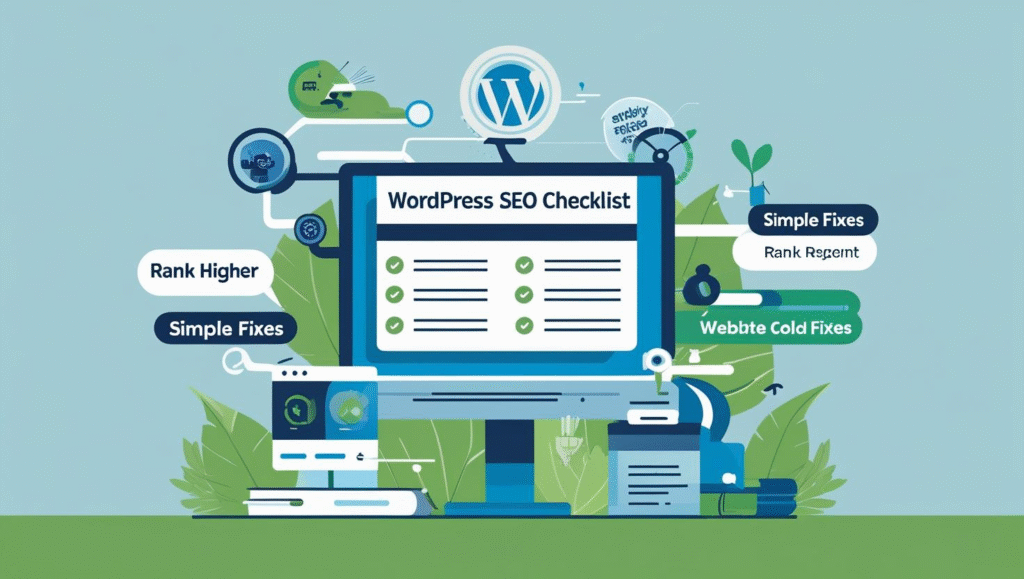
11. Mobile Optimization & Responsive Design
Over 70% of users browse on mobile. Google indexes mobile-first.
What to Check:
- Responsive theme or builder
- Legible fonts
- Tap-friendly buttons
- Avoid intrusive popups
Use Google’s Mobile-Friendly Test tool.
12. Site Speed & Core Web Vitals
Speed is a ranking factor.
Key metrics:
- LCP (Largest Contentful Paint) < 2.5s
- FID/TBT (Time to Interactive) < 100ms
- CLS (Cumulative Layout Shift) < 0.1
Use:
- WP Rocket / LiteSpeed Cache
- Cloudflare CDN
- Fast themes like Astra, Blocksy

13. Enable Schema Markup (Rich Snippets)
Schema enhances your snippets in search with:
- Ratings
- FAQs
- Recipes
- Events
Use Rank Math or Schema Pro to apply it to posts, products, or reviews.
14. Secure Your Site with HTTPS
SSL certificates are a must for ranking.
- Provided free via Let’s Encrypt or hosting
- Makes your URLs start with https://
- Prevents “Not Secure” warnings in browsers
15. Create & Submit XML Sitemap
Sitemaps help Google discover your content faster.
Use your SEO plugin to:
- Generate a sitemap
- Submit it to Google Search Console
- Resubmit after major content updates
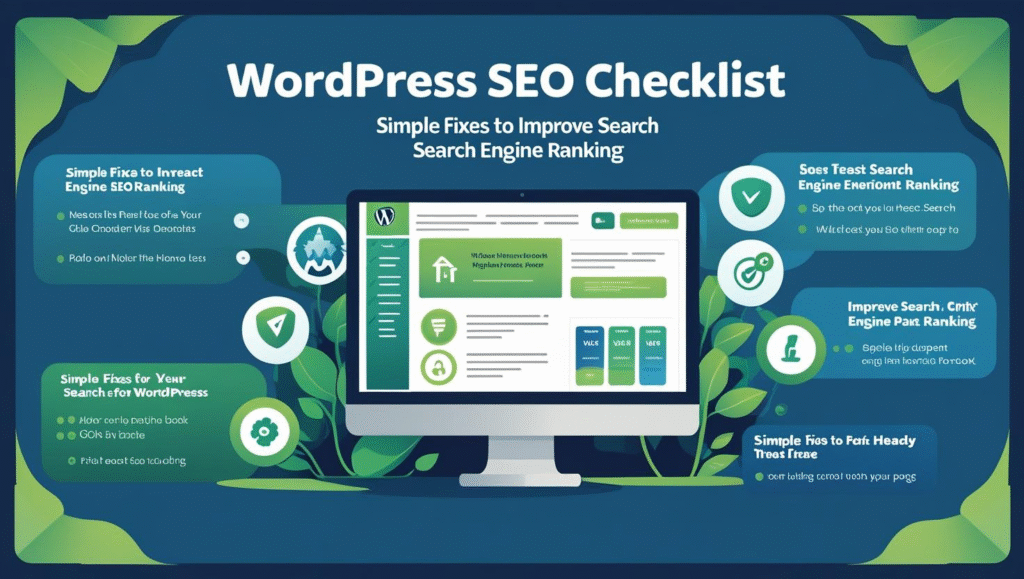
16. Use Robots.txt Correctly
Control which parts of your site Google can crawl.
Sample:
txtCopyEditUser-agent: *
Disallow: /wp-admin/
Allow: /wp-admin/admin-ajax.php
Avoid blocking CSS/JS unless necessary. Test with Search Console.
17. Fix Broken Links WordPress SEO Checklist
Broken links hurt SEO and user experience.
Tools to find them:
- Broken Link Checker
- Ahrefs Site Audit
- Screaming Frog
Redirect dead URLs using 301 redirects via Rank Math or Redirection plugin.
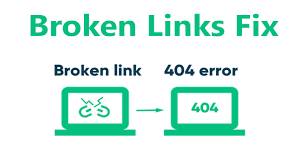
18. Enable Breadcrumbs
Breadcrumbs improve UX and site structure understanding.
- Appear in SERPs
- Help with navigation
- Add via theme or SEO plugin
Example:
Home > Blog > SEO > WordPress SEO Checklist
19. Leverage Social Sharing
Social signals are indirect ranking factors.
- Add social sharing buttons (via AddToAny, Monarch)
- Encourage sharing with CTAs
- Enable Twitter Cards & Facebook OG tags
20. Regular SEO Audits
WordPress SEO Checklist Monthly or quarterly audits help maintain performance.
Check:
- Indexing errors
- Content decay
- Meta tag optimization
- Mobile speed
- Analytics vs Search Console discrepancies
Use tools like SEMrush, Sitebulb, Google Lighthouse
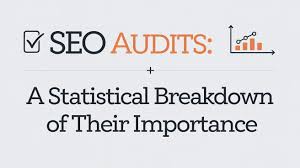
21. Final Tips for Ongoing SEO Success WordPress SEO Checklist
- Keep learning: Follow blogs like Moz, Backlinko, Search Engine Journal
- Stay updated on algorithm changes
- Update old content regularly
- Monitor keyword performance
- Don’t forget UX — it’s now part of SEO

Final Thoughts
WordPress SEO Checklist SEO can seem overwhelming, but following a clear, practical checklist makes it simple. By applying the tips in this post, your WordPress site will be well-positioned to rank higher, load faster, and attract more organic traffic in 2025 and beyond WordPress SEO Checklist.
Start small, optimize consistently, and the results will follow WordPress SEO Checklist.
Would you like me to:
- Add SEO-optimized images with alt text?
- Format this for WordPress with Rank Math TOC block?
- Include outbound/internal links to key plugins and resources?
